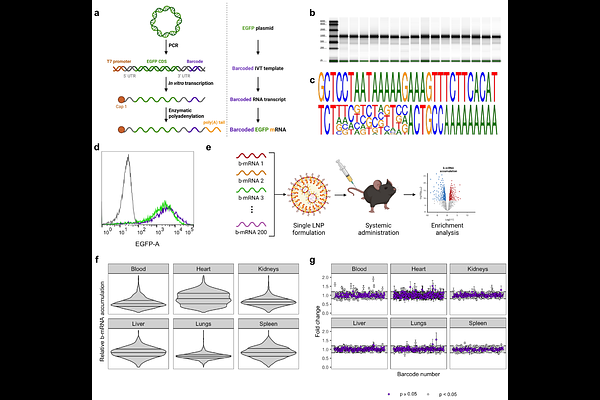High-throughput in vivo screening using barcoded mRNA identifies lipid nanoparticles with extrahepatic tropism for cancer immunotherapy

High-throughput in vivo screening using barcoded mRNA identifies lipid nanoparticles with extrahepatic tropism for cancer immunotherapy
Hamilton, A. G.; Thatte, A. S.; Xu, J.; Luo, Z.; Safford, H. C.; Swingle, K. L.; Muscat-Rivera, J.; Kegel, M.; Han, X.; Joseph, R. A.; Murray, A. M.; Geisler, H. C.; Whitaker, R. C.; Xue, L.; Spektor, R.; Melamed, J. R.; Weissman, D.; Mitchell, M. J.
AbstractInterest continues to grow in the use of mRNA vaccines for cancer immunotherapy. While effective for immunization against infectious diseases, current clinical lipid nanoparticle (LNP) formulations used for mRNA delivery suffer from off-target accumulation, poor immune transfection, and reactogenicity, limiting their application to cancer immunotherapy. Development of new mRNA LNPs is severely bottlenecked by the LNP discovery process, which is historically low-throughput due to reliance on low-plexity measurements. Here, we develop a next-generation high-throughput in vivo mRNA LNP screening platform based on barcoded mRNA (b-mRNA). Using this b-mRNA screening platform to simultaneously evaluate 122 LNPs, we identify novel LNP formulations capable of potent hepatic and extrahepatic transfection. We employ novel biochemical characterization techniques to analyze nanoparticle protein corona formation with single-particle resolution and gain insight into the influence of protein adsorption on hepatic and splenic transfection. We evaluate a lead LNP candidate for therapeutic cancer vaccination in a syngeneic mouse model of melanoma and demonstrate a significant reduction in tumor burden and increase in survival compared to a clinical mRNA LNP formulation. Together, our results demonstrate the value of advanced LNP screening and characterization techniques for the development of next-generation mRNA therapeutics and vaccines.